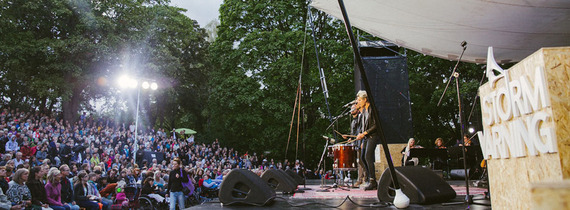We have reached a point in time where the science is unambiguous and the technological solutions are available, but we are not using them. Why? My short answer is that the issue of climate change hasn't been communicated well enough. Up until now, climate change has been treated -- and communicated -- as a special interest, a charity cause or a scientific field. "If you're not an environmentalist or a scientist, climate change is not for you to fix".
I have been creating communication concepts within digital media, music and film for my whole professional carer. Two years ago I started an organization devoted to creating concepts that joins scientists, communicators, filmmakers, musicians and artist to communicate sustainability science to a broader public in Sweden.
My engagement in this matter started thanks to my girlfriend. She is a climate researcher and despite my engineering background it took her years of telling me so often at the kitchen table how serious the issue of climate change is before I really got it. It is one thing to hear about it, the risks and probabilities, and another to really take it in.
Everyone does not have the luxury of having a climate scientist at their kitchen table but everyone has the right to know the gravity of the situation -- but also the solutions available. As I see it we're facing a crisis of communication because we, as Swedish citizens, have not really "taken it in" and at the same time our leaders are waiting for us to show that we give them mandate to really start acting.
So what need to be done
We need to get the broad masses feeling included, not excluded by complicated figures and too much detail. Only by being included will people see the possibilities instead of the challenges. The problem is that "climate change" has, to a great extent, been stuck with natural scientists and environmental activists, with a great gap between them and the rest of us. Journalists have also largely failed to produce in-depth, continuous reporting on climate change. And marketing agencies, with proven skills to affect people, seem to be waiting for a client to give them a case before picking up the communication challenge of climate change. But it's not just communicators' and journalists' lack of seeing this as their question to raise -- in my view, academia and researchers have a large portion of responsibility, often overconfident in their own capacity to communicate their findings to a wider audience.
 More than 3000 people came when Swedish artists and scientists joined forces to raise the issue of climate change in a new way in the summer of 2014.
More than 3000 people came when Swedish artists and scientists joined forces to raise the issue of climate change in a new way in the summer of 2014.
Facts are important, but feelings are equally important. Climate change needs to be communicated to both brain and heart at the same time. Engagement and the will to show support for a cause grow from the heart, not the brain, and "no one will get goose bumps from a scientific report". Today we judge the legitimacy (of a cause) from how it looks and feels, not just from the facts that supports it. As for the issue of climate change, it doesn't need any more cardigans; it deserves a nice looking suit.
I'm not saying that scientist should start to dance to attract attention among new audiences. They should do what they do best, but then let other people -- outside the academia and the classic environmental movements -- help communicate their important work on what actions we need to take. I'm asking for closer collaboration, and perhaps a raised level of respect for the craft of communicators and marketers. Rest assure the institutions and corporations with interest in delaying climate action are using professional marketing experts.
There is hope
I have seen the sparks flying when marketing and creative agencies meet climate professors to discuss climate change outside university seminar rooms. New communication ideas and angles are created, but equally important new ambassadors for this question are born, within a whole new part of society. Ambassadors who not only raise hope by showing that they care but who also have the ability and experience to package and broadcast messages in a way that inspires beyond the already convinced. These folks also know that without a silver lining most people won't be eager to jump on-board and engage in a cause such as stopping climate change. And I don't blame them.
Things have started to move, and as academic institutions in Sweden continue to open up their vaults and invite marketing agencies and communicators, I urge my fellow communication professionals to on our part work hard to not over-simplify, but adapt the message and create bold communication strategies to get the attention of the target audiences we need to reach to accelerate the sustainability revolution.
I am convinced that we can -- and faster than you'd think -- get a majority of our citizens to move from hearing the facts to getting engaged and push for real action on climate change. What we need is to give the issue of climate change new connotations -- where the person lifting climate change on your next dinner party is not the annoying environmentalist, but the forward-thinker who's style the rest of us wants to copy.
This post is part of a "Nordic Solutions" series produced by The Huffington Post, in conjunction with the U.N.'s 21st Conference of the Parties (COP21) in Paris (Nov. 30-Dec. 11), aka the climate-change conference. The series will put a spotlight on climate solutions from the five Nordic countries, and is part of our What's Working editorial initiative. To view the entire series, visit here.